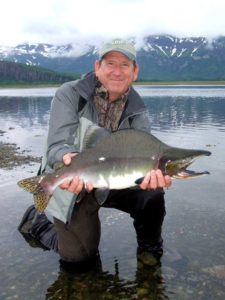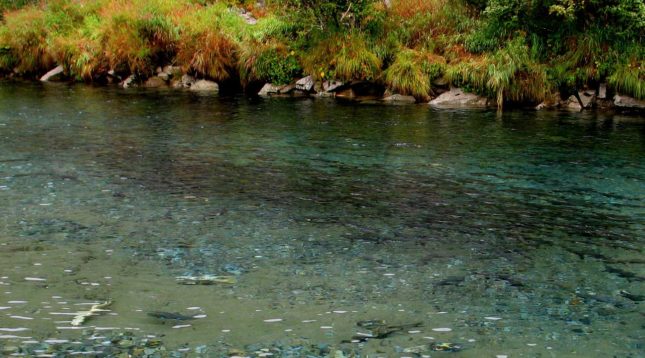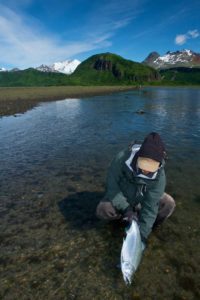Epic Blog
Seven Species Series: Pink Salmon
09.07.20
Part Six: Pink Salmon
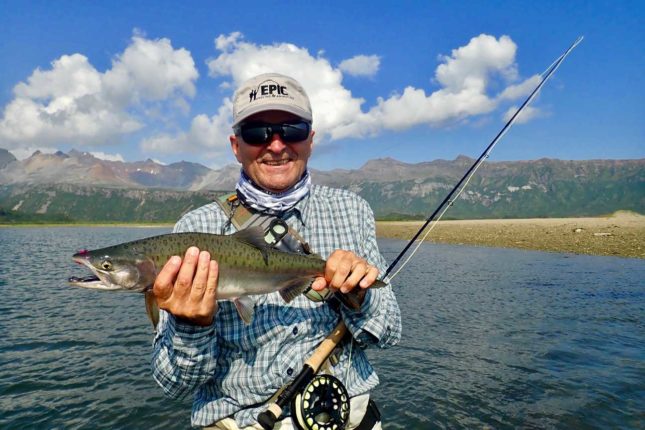
Pink salmon may be the smallest salmon species, but they show up in huge numbers… good for non-stop fly fishing action!
Early August, 2017. The tide had finally turned. From the heights of our remote camp perched high above the sprawling estuary that stretches out for several miles below us we could see the increasing out flow of the tide as the sea called it back. This was still during set-up, the nearly two week long period that it takes to transform a peaceful series of dirt tent pads scattered amongst a winding maze of alder stands and thickets of cow parsnip and fireweed into a small village.
To the mouth
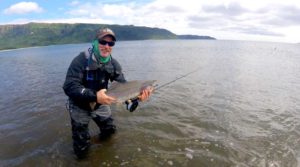
The most exciting place to fly fish for pink salmon is off the beach, directly in salt water. Calm days are best.
The days are already becoming noticeably shorter than when we first arrived on the ground back in June for OUTPOST camp duty. Still, there is enough light to work by lasting well into the evening. Soon it will be time to call a halt to the day’s labor, and we will huddle into the massive cook tent that stands at the doorway of our camp for some hot food. But there is one last task to complete before the day is through, a dump run. Rus and I climb down the steep flight of stairs clinging to the heavily treed hillside that delivers you from the promontory of camp to the tidal flat below.
We carry our “chum” (food waste) in two heavy five gallon buckets down with us. Rus kayaks out to where one of the two inflatable catarafts are moored in deep water, retrieves it and motors back to where I wait on the shoreline. We drive down to the mouth of the tidal flat, where it empties out into the bay. Glaucous-winged gulls and harbor seals keep a watchful eye as we turn the boat into the outgoing current and empty the contents of the buckets into the sea. Normally after this we would head straight back to camp, but we don’t.
Pink Salmon
Pink Salmon, Pinks, Humpback, or simply Humpy are the smallest member of the Pacific Salmon group Oncorhynchus. Their latin name, Gorbuscha, is derived from the Russian word commonly used to describe them and their predominant “hump.” Spawning males develop this exaggerated feature as they move into their natal rivers and streams. Imagine a cartoonishly arched back rising steeply along their spine before falling off as it leads to their dorsal fin.
These salmon are unique for sticking to a regimental two year spawning cycle that oscillates between odd and even numbered years for the Pacific and Bering sides of the Alaska Peninsula. The odd years see substantial returns on the Pacific side, while the even years see larger returns on the Bering side. This year, 2017, we will see a pink salmon return to our small coastal stream of epic proportions. While they might be the smallest of their salmon brethren, they are also the most abundant in number, and now wave after wave flood into the mouth of our drainage.
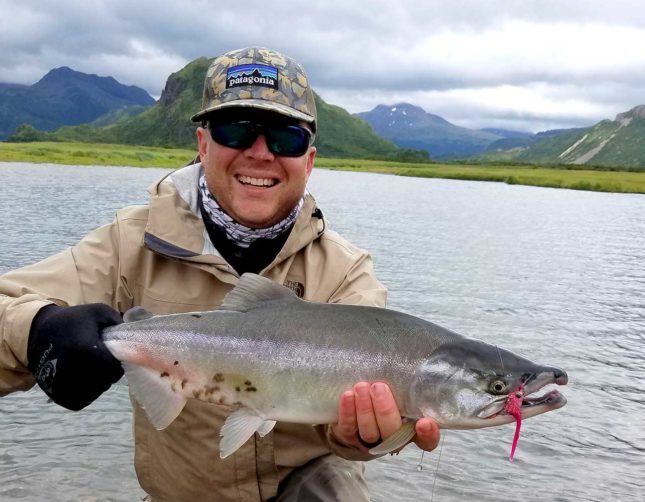
At SAFARI, female pink salmon run 2 to 4 pounds, males run 3 to 8 pounds. Their fight deteriorates quickly in fresh water, but are very feisty when caught in or near salt water.
The Braids
Rus motors the boat up into the long side channel that meets the main branch of the tidal estuary no more than fifty yards from where it drains into the open ocean. We drive along this watery corridor. A spit of sand covered in thick tufts of wild beach rye is all that stands between us and the entirety of the Northern Pacific as we race against the outgoing tide. The channel braids into a myriad of narrow veins as we approach our destination: the mouth of our creek where it spills into the tidal flat. There are huge root wads and submerged log jams scouring the shallow bottom, making navigation treacherous. We clear the last obstacle and throttle into the lowest stretch of this nameless coastal river.
Dark water
Because there was still much work to do before guests arrive, up until that point this was the furthest I had been outside of the confines of our camp. I had not stepped foot on the cobbled gravel bars that take you up river for miles and miles. I hadn’t crossed the flat during low tide to negotiate the bear mazes that zigzag through the thick brush underneath the scree fields of Harley Hill. I hadn’t ventured out into the bay to jig for Halibut and watch puffins fly low over the ocean in their never ending search for food. And I had yet to fly across the ridges and valleys that separate our bay from the sister bays we visit on a weekly basis for heli-fishing. This was all dark water to me.
A river of fish
As we progressed up the main channel of our small coastal creek the river erupted with swarms of scattering fish. The water under the boat was deep, deep enough to not be able to see the bottom where it came up tight against the steep grassy banks. Under us, on either side of us, and in front of us passed a never ending train of salmon. They looked like dark torpedoes in the green water as they flushed past the boat. Most of them, untold hundreds, were pink salmon. Every once in a while a larger profile would flash iridescently amongst the fleeing hordes, a salty chum salmon.
We crawled forward, slowly moving against the ceaseless torrent of fish that swam en masse underneath the waters surface. It didn’t stop. The further we drove up into the creek, the more fish spooked and passed alongside the boat. Finally it reached its zenith. The river ran black with the dark silhouettes of pink salmon as they hurried away from the approaching juggernaut. I remember thinking as I stared down into the depths, as if in a trance, that the water itself seemed to come alive with all of those fish writhing as one just beneath us. A specter of nature’s uncanniness. A vision from the past. Once seen, never forgotten.
To this day I can’t recall ever bearing witness to so many fish in one place and at one time since that evening.
Written by Drew Griffith (aka “Machete”). July, 2020
Find more Machete articles here.
Posted in All Posts, Fishing, SAFARI

